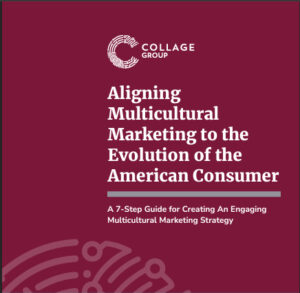7-Step Guide to Create An Engaging Multicultural Marketing Strategy

7-Step Guide to Create An Engaging Multicultural Marketing Strategy
In today’s era of increasing cultural diversity, consumer research professionals play a crucial role in unlocking the full potential of Multicultural marketing. They empower marketers to create impactful campaigns that resonate with diverse audiences and drive business growth.
In the U.S. Multicultural consumers make up 42% of the population, with a staggering 140 million individuals – a figure set to grow. In fact, the United States is set to become majority Multicultural by 2042 – and some states have already made that leap. As the U.S. consumer landscape evolves, there’s a need for brands and agencies to improve their understanding of culture – across race, ethnicity, generation, sexuality, family relationships, and more – to evolve their marketing strategies for authentic engagement.
With this in mind, Collage Group provides valuable insights into Multicultural marketing to help you understand its evolution and best practices. And by implementing these insights, your business can enjoy the benefits that come from doing so.
Here, we offer a 7-step guide to help you create an engaging Multicultural marketing strategy. This guide is designed to be used by consumer insight professionals and marketers together in a collaborative process.
Our guide showcases what successful Multicultural marketing campaigns look like, drawing inspiration from leading brands such as Nike and Coca-Cola, while also highlighting the crucial role consumer research data plays in driving marketing success.
Click on the links below to jump to your section of choice:
- What is Multicultural marketing?
- Why is Multicultural marketing important?
- Insights on the state of Multicultural marketing: Its evolution, best practices, and lessons learned
- The benefits of Multicultural marketing
- Applying consumer research insights to create a Multicultural marketing strategy (7 Steps)
- Multicultural marketing done right: Examples of diversity marketing
Fill out the form to download our whitepaper “Aligning Multicultural Marketing to the Evolution of the American Consumer” and read below for the latest insights.

Multicultural marketing is the practice of targeting diverse consumer groups with tailored marketing strategies that account for different cultural backgrounds, values, and preferences.
Multicultural marketing creates opportunities from diverse cultural referents – such as language, traditions, celebrations, religion, and other concepts. The aim is to connect with diverse populations, form long-lasting and positive consumer relations, and break advertising norms by highlighting people or groups that may be underrepresented or misrepresented.
The widespread adoption of Multicultural marketing began to emerge in the late 1960s when the potential of addressing consumers by their racial and ethnic identities was first acknowledged. Since then, Multicultural marketing has gradually evolved, with the 1990s marking a significant peak as businesses increasingly recognized the value of reaching out to different ethnicities. Notably, major companies like Coca-Cola have implemented dedicated Multicultural marketing strategies after realizing the growth potential it holds for their business.
Today, marketers must understand the diverse nature of societies, with many countries characterized by a rich blend of multiple cultures rather than being dominated by a single group. By embracing Multiculturalism, companies can tap into the immense purchasing power of historically underrepresented people, build brand loyalty, and foster long-term customer relationships.
Multicultural marketing ensures inclusivity, meaning marketing campaigns resonate with diverse audiences, and also helps brands stay relevant in an increasingly interconnected and culturally diverse world.
The success of any given Multicultural marketing campaign depends on Cultural Fluency – characterized by the ability to connect with shared experiences and understanding intersectionality, to form positive relationships with today’s diverse consumers.
Representation alone is not enough to prove that your brand cares about consumers across cultures. Does your brand truly understand America’s cultural diversity? And are you effective in authentically engaging with each consumer segment?
In an impactful collaboration with Ad Age for the event, “Ad Age Next: Multicultural Marketing“, Collage Group had the pleasure of joining other leading brands, including Unilever, Twitter, BET Networks, and PepsiCo, to delve deeper into Multicultural consumer engagement strategies. Collage Group’s Vice President of Client Services, Zekeera Belton, participated in a panel focusing on the term “Multicultural” and the state of Multicultural marketing – how it’s evolving, best practices, and lessons learned.
The following includes key insights discussed during the panel and covered in Collage Group research your brand needs to understand to remain relevant and drive growth across diverse segments. Before delving deeper into our findings, here’s a topline summary:
Multicultural marketing research key insights:
- Multicultural marketing insight #1: Collage Group research shows that Multicultural Americans are increasingly interested in supporting brands that support them.
- Multicultural marketing insight #2: Multicultural Americans are largely unsatisfied with portrayals of their own racial and ethnic identities in advertising. This comes at a time when cultural identity is more important than ever and backlash against inauthentic representation is as big as ever. There’s clearly more work marketers can do to improve.
The majority of Hispanic (60%), Black (76%), and Asian American (58%) populations want to support those brands that support them. However, these racial and ethnic segments are becoming less satisfied with how they’re portrayed.
(% of respondents who say they’re more likely to buy from a brand that supports their race or ethnicity.)
A large proportion of Hispanic (66% an increase of 13% from 2021), Black (62%, an increase of 16% from 2021) and Asian (54%, an increase of 11% from 2021) populations stated they were satisfied with how their race and ethnicity are portrayed in advertising. These findings mark the highest levels of contentment since the examination of this sentiment began. That is, results from Collage Group’s 2023 American Now survey revealed massive improvements across racial and ethnic segments. Multicultural consumers express a double-digit increase in satisfaction regarding their portrayal in advertisements compared to 2021. This data proves that the push toward more inclusive marketing is working. And the message here is to keep moving forward on this. However, it’s important to note that the awareness about inclusive marketing is higher, and there’s also been some high profile backlash – from bad actors and often from unexpected places.
With insights like this in mind, Collage Group has developed a range of solutions to help brands continue to succeed in the multicultural landscape of America. Our shared-cost syndicated research model embedded into our world-class Cultural Intelligence Platform gives brands access to more than 10 years of diverse consumer insights with new reports weekly. Our members also have access to our CultureRate reports that assess the Cultural Fluency of brands and ads – our database is the largest of its kind, growing annually by more than 200,000 responses. And we offer much more.
Leveraging consumer research and cultural intelligence data will help you build a successful Multicultural marketing campaign. This is why consumer research professionals and marketers must work together when devising a marketing plan. When done right, Multicultural marketing helps businesses better align with their customers, which brings about immense benefits, as discussed below.
Multicultural marketing responds to evolving consumer trends as minority populations expand
Recent population projections conducted by Census highlight the significant role Multicultural Americans play as the primary driving force behind America’s future growth. The statistics indicate that the U.S. is projected to transition to a “minority White” status by 2045. In that year, White Americans are estimated to make up 49.7% of the population, while Hispanics will account for 24.6%, Black Americans for 13.1%, Asian Americans for 7.9%, and multiracial populations for 3.8%. These figures underscore the evolving demographics and the increasing influence diverse racial groups will have in shaping the nation’s market.
Multicultural marketing harnesses the economic influence of diverse communities
According to Collage Group’s 2024 Multicultural Demographics research, it’s evident that Asian Americans, African Americans, and Hispanics possess substantial economic influence, emphasizing a need for companies to move beyond a one-size-fits-all marketing approach.
As of 2024, Multicultural Americans constitute 42% of the U.S. population, reflecting an increase of nearly 4 million since 2021. Projections indicate that this demographic will become the majority by 2050. This population growth has led to a significant surge in the buying power of Black, Asian, and Hispanic communities. Notably, Asian Americans rank as the highest earners by race and ethnicity in the U.S., while Hispanic and Black populations have experienced substantial growth in average annual expenditures. The purchasing power of each multicultural segment is expanding at a much faster pace than that of White populations. By 2026, Hispanic buying power is anticipated to reach $2.8 trillion, reflecting a remarkable 320% increase. Similarly, Black buying power is projected to reach $2.1 trillion, representing a 183% increase, and Asian consumers are expected to have a buying power of $1.9 trillion, showcasing a substantial 367% increase from 2000 to 2026.
Multicultural marketing fosters stronger brand loyalty by embracing diversity
According to Microsoft Advertising, 70% of Gen Z consumers trust brands that portray diversity in their advertisements more than those that don’t. Adding to this, findings from Adobe’s research reveal that 38% of consumers, spanning across generations, are more inclined to trust brands that effectively showcase diversity in their marketing strategy. Consequently, a substantial 71% of audiences expect brands to actively promote diversity and inclusion in their online advertising efforts.
Applying consumer research insights to create a Multicultural marketing strategy (7 Steps)
To devise an effective Multicultural marketing plan, consumer research professionals and marketers must be aware of three key principles before collaborating. These principles serve as guiding rules for crafting a strategy that resonates with diverse audiences:
Where can we send you the full article?
This post includes a small sample of the deep cultural intelligence that fuels growth for our members. Contact us to unlock more content like this.